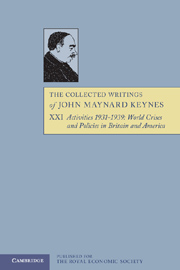Book contents
- Frontmatter
- Contents
- General introduction
- Editorial note
- 1 THE CURRENCY QUESTION
- 2 CHEAP MONEY, WISE SPENDING AND THE MEANS TO PROSPERITY
- 3 THE WORLD ECONOMIC CONFERENCE
- 4 THE NEW DEAL
- 5 THE LULL SURROUNDING THE GENERAL THEORY
- 6 SLUMP AND REARMAMENT
- 7 TOWARDS WAR
- List of Documents Reproduced
- Acknowledgements
- Index
5 - THE LULL SURROUNDING THE GENERAL THEORY
Published online by Cambridge University Press: 05 November 2012
- Frontmatter
- Contents
- General introduction
- Editorial note
- 1 THE CURRENCY QUESTION
- 2 CHEAP MONEY, WISE SPENDING AND THE MEANS TO PROSPERITY
- 3 THE WORLD ECONOMIC CONFERENCE
- 4 THE NEW DEAL
- 5 THE LULL SURROUNDING THE GENERAL THEORY
- 6 SLUMP AND REARMAMENT
- 7 TOWARDS WAR
- List of Documents Reproduced
- Acknowledgements
- Index
Summary
Throughout the rest of 1934 and all of 1935 Keynes's activities were centred on two major projects, the completion of his General Theory, and the Arts Theatre, Cambridge. Not that he gave up all outside activities, for he was still involved in lecturing, bursaring for King's, his two insurance companies, the Economic Advisory Council and other areas. His published output was small, however, even if it was varied.
On his return from the United States, Keynes found the Committee on Economic Information concerned with ‘the co-ordination of different agricultural and industrial considerations in formulating trade policies’. This charge from the Government was a result of the desire of the Minister of Agriculture for an extension to other foodstuffs of the ‘levy-subsidy’ scheme adopted for wheat in 1932, whereby British growers received a subsidy on output financed out of proceeds of a levy on imports. The Committee asked each member to write a note on the factors that should be borne in mind in writing the report. Keynes replied as follows.
MEMORANDUM
I suggest that the Memorandum for which the Prime Minister has asked should be composed of three parts.
The first part dealing with the general philosophy of long-period developments might, I think, follow the lines of paragraphs 1 to 8 of Mr Henderson's Memorandum. It is useful and important to distinguish, as he does, between the object of protecting our agriculture from disaster and maintaining it at its existing level from the object of a long-period programme of expansion which would represent an important departure from the position which we have occupied hitherto in the world economy.
- Type
- Chapter
- Information
- The Collected Writings of John Maynard Keynes , pp. 340 - 382Publisher: Royal Economic SocietyPrint publication year: 1978

